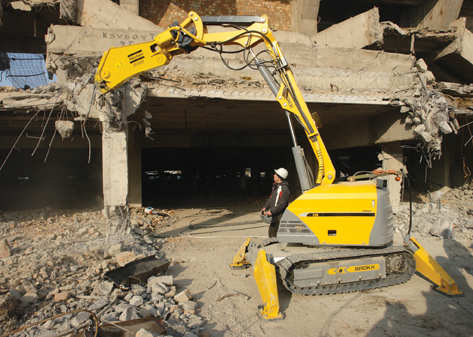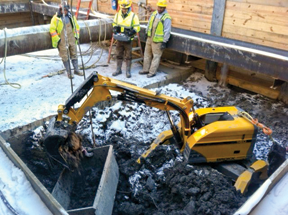Breaking Into Rental
Powerful machine offers advantages –so why isn’t it sweeping the rental world?
by Mike Martin
Remote-controlled demolition robots can perch on the edge of a bridge where demo work is tricky, steadily crushing concrete for hours. They can enter the ground floor of a high-rise and, as part of a major renovation, using quiet electric power, demolish an old bank vault, with no fumes to bother office workers. And they can walk across a foundry floor, ignoring blistering heat, and clean slag from a smelter. All with the operator safely standing yards away.
Curious about what these machines do, and learning that they aren’t a typical rental product, Pro Contractor Rentals talked with Peter Bigwood, vice president of sales and marketing for Brokk Inc. Bigwood, former president of Atlas Copco Construction Tools U.S., has been with Brokk for three years. Use of the equipment is growing, he says, with several customers now owning a small fleet of the machines. Sales were “way up” in 2012, flat last year, and trending up again this year. This suggests that use of demolition robots is expanding. Plus, Bigwood says, the company consistently takes inquiries from people who need the machine for one project and are looking to rent rather than buy.
 |
| Remote-controlled demolition robots can be tireless workers. Brokk is carefully breaking into rental, seeking the right type of rental center that can acquire the machine and target the right type of customers for rentals. |
Because of this, Brokk is taking a measured approach to expand rental outlets, dividing the U.S. into seven regions, placing sales people in each one. Sales staff are responsible for direct sales, including sales to rental centers, and
to funnel rental leads to these stores. They have some strong, longstanding rental outlets, including Brock Rentals in Monroe, Wash., and Robo-Breaking Co. just outside New York City, recently added Walter Pratt & Sons out of Albany, NY, and will add more.
“Our goal is to increase access to the machines among a wider population of contractors and other users,” he explains. The company will focus on finding rental centers that have a good sense of what specialized machine rentals are all about. “The key, really, is to recognize how specialized these machines are. We’re not the next Bobcat. These are niche machines – but with a lot of niche applications where they really do a great job.”
The Brock Rentals website lists 24 applications where the machines were used, including smelters, tunnels, subways, bridges, dams, building renovations and nuclear decommissioning. Bigwood says the majority of applications are in
traditional construction – demolition projects, concrete removal, non-residential demolition and heavy civil projects.
Safe, Powerful Precision
Within these niche applications, he emphasizes, safety is an underlying theme. If you think about where you need power in tight spots there are potential dangers for operators. “With this equipment, you bring power and finesse to the project, whether you’re breaking slag out of a furnace or concrete at the base of a bridge. And you do so while keeping operators at a safe distance.”
It’s fair to say Bigwood is biased, and he consistently expresses appreciation for the work these machines can do. “It’s easy to look at one and say, oh, it’s an excavator without a cab. But it’s important to recognize that these machines – the vast majority of which are electric-powered – have really eye-popping power-to-weight ratios. Our 1-ton machine will have a hydraulic breaker on the end of it that would normally be matched up with an excavator that would be, probably, three and a half tons. So you can put this little 1-ton machine on a building or a bridge, in an elevator, in a stairwell, and in effect you’re bringing the power of a much larger excavator to bear on the application.”
The belt-on wireless remote control gives operators the potential to view work from all angles, “so they can use that power in a very fine-tuned way,” Bigwood explains. They can knock concrete off a structure without damaging rebar or beams. Or, with a construction grapple attachment, punch a hole in dry wall, grab a stud, and bring the wall down quickly, efficiently and with the operator standing out of the way.
There are even more unique ways to put remote-control capability to work. Bigwood describes a water tower demolition project that required not toppling the tower. The contractor used a crane to hoist the demolition robot into place, with the operator in a man-basket lifted by another crane, working in tandem to dismantle the tower from the top down.
 |
| The smallest machines can 'walk' into buildings or easily be maneuvered into place. |
Increasingly, the “green” aspect of using electric power is an advantage. Although Brokk offers two diesel-powered models, the great majority of machines are electric, requiring 480 volt, 3-phase power. Projects in schools and colleges, interior strip-outs in shopping malls (typically a tight-deadline project), the bank vault project in an occupied office building, removing the large concrete bases used for MRI machines in hospitals, anywhere diesel or propane-powered machines can’t be used, have potential for demolition robots.
Projects that benefit from all or most of these elements – no exhaust, power, precision and safety – “are archetypal Brokk jobs,” Bigwood contends. “You won’t be able to get large excavators in there for the power you need. You can’t use diesel or propane. And they could turn into a long project if you’re trying to get the job done with a crew using 90-pound jackhammers.”
Which brings up another benefit: These machines reduce the workload and users won’t face the fatigue and worker’s comp issues related to physical labor.
Acquisition cost
Given these advantages, why isn’t the equipment moving more rapidly into rental channels? In part, because contractors and others who can benefit from the machine may not be aware of its value. Which is why the company is adding dedicated territory sales people to find new prospects in every likely industry.
Then there’s the capital outlay. The 1-ton machine will cost about $125,000. With this, Bigwood recognizes, comes the need for appropriately high rental rates. “In the rental business, utilization is king. But with niche products you need a different approach. Utilization for this equipment won’t be up there in the numbers that you’d get from, say, a 185 cfm compressor.”
Rates will have to be a higher percentage of the acquisition cost than standard rentals, but if they need to push 10 percent, is that feasible? It may go hand-in-hand with where the company is seeing rental success – those that handle specialty equipment. For example, Walter Pratt & Sons specializes in tracked drills, and is transferring that ability into success with renting demolition robots.
So, it’s a non-standard rental that requires developing or having more expertise in applications where the machine shows its advantages. If you think about safety, no emissions, and power in a relatively compact package, the opportunities for the machine are likely to grow. Add to that projects where manual labor isn’t the best option for getting a project done on time and, with reduced potential for injuries, a remote-controlled demotion robot can show the ROI rental centers and their customers need.
“If someone is renting a remote-controlled demolition robot, there’s a very good reason they need it,”
Bigwood says, which makes higher rental rates more attainable. “And I will say this, in all candor, that once someone has done a couple of jobs with their Brokk machine, they have other people ask them about using them for various projects. A customer in Houston said he hemmed and hawed and finally bought his demolition robot and told us
everyone is asking if he can come and do work for them. And that’s music to our ears.”
Versatility with attachments
Brokk machines are delivered with breakers. Buckets are very common, as well, for removing debris.
“Our crushers are made by a sister company – Darda – and match up beautifully with Brokk machines,” Bigwood says.
Construction grapples, made by Kinshofer, another sister company, are perfect for interior strip-outs, pulling down walls or suspended ceilings. Once down, “you can sort through the material, pick it up, shake it, and separate it into piles.”
Drum cutters or scabblers are often used in tunneling or mining. “We’ve also seen it used on concrete. For
example, on one project the contractor used it to grind concrete at the top of a dam to form channels for the water to disperse.”
A rock drill, with sizes of drills matched to the different models of machine, is also available. There are others, but these six are used on the bulk of the projects using the demolition robot.









